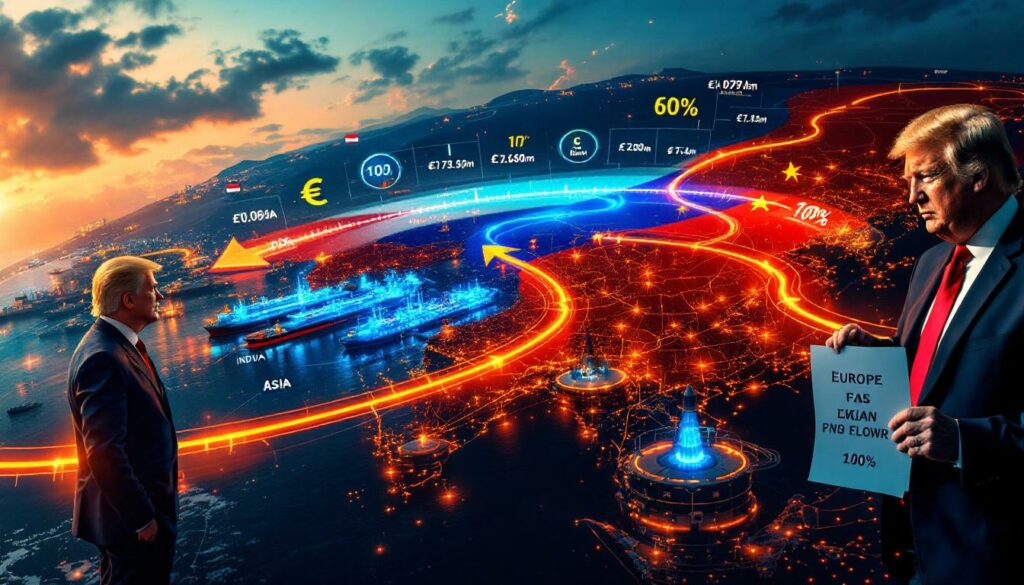How Has Russia's Fossil Fuel Trade Shifted Since the Ukraine War?
Russia's fossil fuel exports have undergone a dramatic transformation since the invasion of Ukraine in February 2022, creating one of the most significant reorientations of global energy flows in recent history. What was once primarily a westward flow of oil, gas, and coal has pivoted sharply eastward, as Asian nations have stepped in to replace European buyers constrained by sanctions and moral concerns.
According to data from the Centre for Research on Energy and Clean Air (CREA), this shift wasn't merely a temporary adjustment but a fundamental restructuring of global energy trade patterns that continued throughout 2022 and 2023. The reorientation required massive logistical changes, including new shipping routes, payment mechanisms, and trading partnerships.
Market Insight: Russia's ability to redirect exports east demonstrates the inherent flexibility of global commodity markets, where supply tends to find demand regardless of political barriers if the price incentive is sufficient.
This eastward pivot has had profound implications for global energy security, pricing structures, and geopolitical alignments. Western attempts to isolate Russia economically through sanctions have been partially undermined by the willingness of Asian nations to increase their purchases, albeit at discounted rates that still benefit their economies.
Who Are the Largest Buyers of Russian Fossil Fuels Since 2023?
China Leads as Primary Purchaser
China has emerged as the undisputed leader in purchasing Russian fossil fuels since January 2023, according to OilPrice.com analysis published by ZeroHedge in August 2025. This leadership position represents both an economic opportunity and a strategic geopolitical choice for Beijing, which has deepened its energy relationship with Moscow despite Western pressure.
Chinese state-owned enterprises have been particularly aggressive in securing long-term supply agreements at favorable prices, with some contracts extending 30+ years for natural gas. These arrangements provide China with energy security while offering Russia a reliable revenue stream despite Western sanctions.
The volume of Russian crude oil flowing to China has reached historic highs, with specialized tankers making the journey through both western and eastern routes. Chinese refineries have reconfigured their operations to process the specific grades of Russian crude, indicating a long-term commitment to this supply relationship.
India's Dramatic Import Increase
India ranks as the second-largest buyer of Russian fossil fuels post-invasion, marking an extraordinary transformation in its energy procurement strategy. Prior to 2022, India's purchases of Russian energy were minimal, but opportunistic buying has revolutionized this relationship.
Indian refineries have dramatically expanded their processing of Russian crude, taking advantage of discounts that reportedly reached as high as 30% during certain periods. This price advantage has allowed Indian processors to achieve exceptional margins on refined products, which they then export to global markets—including, ironically, to Western nations that have imposed sanctions on Russian crude.
Industry Insight: India's strategic neutrality in the Russia-Ukraine conflict has allowed it to prioritize domestic energy security and economic interests while maintaining diplomatic relations with both Western powers and Russia.
Despite facing significant diplomatic pressure from the United States and European allies, India has maintained its position that energy security represents a national priority. As U.S. Senator Lindsay Graham's reported threat to "crush your economy" directed toward India (among others) indicates, this stance has created tensions with Western partners.
Turkey's Strategic Energy Partnership
Turkey has leveraged its unique geographic position straddling Europe and Asia to become the third-largest buyer of Russian fossil fuels since 2023. This strategic positioning allows Turkey to function not only as a significant consumer but also as a potential transit hub for Russian energy seeking alternative routes to market.
Turkish purchases have increased substantially across all categories of fossil fuels, including natural gas delivered via the TurkStream pipeline, oil shipments through the Turkish Straits, and coal deliveries to Turkish ports. This energy relationship has evolved alongside broader diplomatic engagement between Ankara and Moscow, even as Turkey maintains its NATO membership.
The Turkish government has carefully balanced its Western security alignments with its energy security needs, creating a nuanced position that reflects the complex realities of regional politics in an era of energy transition and geopolitical competition.
How Has the European Union Responded to Russian Energy Dependence?
Initial Reduction Efforts
The European Union now ranks fourth among Russian fossil fuel buyers since 2023, reflecting a significant decline from its previous position as Russia's primary energy market. According to OilPrice.com and CREA data, "EU reductions in purchases were very significant during the first year after Russia's invasion of Ukraine," demonstrating the bloc's determination to reduce its energy dependence on Moscow.
This reduction occurred most dramatically in coal and oil sectors, where alternative suppliers could be more readily secured from global markets. The EU's oil embargo and price cap mechanisms, implemented in December 2022, accelerated this transition away from Russian crude and petroleum products, forcing Moscow to find alternative markets.
European energy security strategies have involved:
- Diversification of supply sources and routes
- Increased LNG import capacity through new and expanded terminals
- Strategic petroleum reserve releases to manage market volatility
- Accelerated renewable energy deployment
- Demand reduction measures
Persistent Natural Gas Challenges
Natural gas dependency has proven most challenging for EU nations to overcome, with several countries still reliant on Russian pipeline supplies. The physical infrastructure constraints of gas delivery—requiring either pipelines or specialized LNG facilities—have complicated efforts to fully disengage from Russian supply.
Countries in Central and Eastern Europe have faced particular difficulties in sourcing alternative gas supplies due to their geographic location and limited interconnection with Western European gas networks. While significant progress has been made in developing new import routes and storage policies, complete independence remains elusive for certain member states.
Leading EU Importers
Within the European Union, "Hungary, Slovakia, France, and Belgium remain the largest buyers of Russian fossil fuels," according to OilPrice.com analysis. This continued purchasing reflects varying circumstances across these nations:
-
Hungary and Slovakia: Geographic constraints and limited alternative supply options have made rapid disengagement challenging. Both nations secured exemptions from certain EU energy sanctions against Russia, citing energy security concerns.
-
France: Despite strong political rhetoric against Russian aggression, certain French energy needs—particularly for specific grades of uranium and nuclear fuel services—have been difficult to source elsewhere on short notice.
-
Belgium: Specialized energy products and existing contractual obligations have contributed to Belgium's continued imports, though at reduced levels compared to pre-war volumes.
Policy Insight: The varying speeds of disengagement from Russian energy across EU member states highlights the tension between collective political will and individual national energy security realities.
Why Have Western Sanctions Failed to Significantly Impact Russian Energy Revenues?
Global Energy Dependency
Despite multiple rounds of sanctions, Russian fossil fuel revenues have not diminished significantly due to global energy market dynamics. According to Voronoi reports cited by OilPrice.com, this resilience stems from "a mix of global dependency on the major energy exporter and opportunism by non-aligned nations."
Russia's position as one of the world's largest energy producers—controlling approximately:
- 10% of global oil production
- 17% of natural gas production
- 16% of coal exports
This scale provides inherent market power that has been difficult to neutralize through sanctions alone. The essential nature of energy commodities means buyers will typically emerge if prices are sufficiently attractive.
Price Mechanisms and Discounts
Russia has successfully employed strategic pricing to maintain market share, offering substantial discounts to friendly nations while still generating revenue above production costs. These discounts—estimated at 15-30% below benchmark prices—have been particularly effective in attracting buyers from price-sensitive economies in Asia.
The global nature of commodity markets has enabled Russian exporters to redirect flows rather than lose them entirely. This redirection has been facilitated by traders, intermediaries, and the opaque ownership structures of certain shipping and trading companies that specialize in moving sanctioned cargoes.
Non-Aligned Nations' Opportunism
Countries not aligned with Western sanctions have increased their purchases of Russian energy, effectively neutralizing the impact of reduced European buying. This opportunistic purchasing has created new trade war oil impact that circumvent Western attempts to isolate Russia economically.
Beyond the major buyers like China and India, numerous smaller nations across Asia, Africa, and Latin America have maintained or increased their Russian energy imports. Many of these countries prioritize economic development and energy affordability over geopolitical considerations, viewing the Russia-Ukraine conflict as primarily a European security issue.
What New Measures Are Being Considered to Restrict Russian Energy Exports?
Potential Secondary Tariffs
The United States is exploring increasingly aggressive measures to restrict Russian energy exports, including implementing steep tariffs on countries that continue to trade with Russia. As reported by the Times of India and cited in OilPrice.com analysis, U.S. Senator Lindsay Graham recently suggested "crushing" the economies of nations like India, China, and Brazil that continue purchasing Russian oil.
These secondary sanctions would represent a significant escalation from previous measures, which primarily targeted Russian entities directly. The approach would effectively force countries to choose between maintaining access to the U.S. market or continuing to purchase discounted Russian energy.
Trump's 100% Tariff Proposal
Former U.S. President Donald Trump has proposed implementing "secondary tariffs" of 100% on countries trading with Russia if no peace deal is reached with Ukraine within 50 days. According to BBC reporting cited by OilPrice.com, this represents a substantial escalation from previous threats of 25% tariffs against buyers of Venezuelan oil made in March.
This proposal reflects growing frustration among some Western policymakers that existing sanctions have failed to adequately pressure Russia. However, the implementation of such measures would represent a significant escalation in economic warfare that could have far-reaching implications for global trade.
Effectiveness Concerns
Energy market analysts express significant skepticism about whether such tariff threats can effectively deter major economies like China and India from purchasing Russian fossil fuels. Several factors complicate the effectiveness of such measures:
- Economic Interdependence: The U.S. has substantial trade relationships with countries like India that would be affected, creating mutual vulnerability
- Alternative Markets: Major economies have diversified trade relationships that could partially offset U.S. market access losses
- Enforcement Challenges: Complex supply chains and intermediary companies can obscure the origin of energy inputs into finished products
- Political Backlash: Aggressive secondary sanctions risk creating anti-Western coalitions among affected nations
Strategic Assessment: Secondary sanctions represent a high-risk approach that could either force compliance or accelerate the fragmentation of the global trading system into competing blocs.
How Has Russia Adapted Its Export Strategy Since 2022?
Pivot to Asian Markets
Russia has strategically reoriented its fossil fuel exports toward Asian markets, developing new infrastructure and trade relationships to accommodate this shift. This pivot has involved not only redirecting existing export capacity but also developing new projects specifically designed to serve eastern markets.
Key adaptations have included:
- Accelerating pipeline projects to China, including Power of Siberia 2
- Expanding port facilities in the Russian Far East
- Increasing rail capacity for coal shipments to Asian markets
- Building new refineries oriented toward Asian product specifications
- Developing Arctic shipping routes to reduce transit times to Asia
This infrastructure development demonstrates Russia's commitment to a long-term strategic reorientation rather than merely a tactical response to temporary sanctions.
Discount Pricing Strategy
To secure new buyers and maintain market share, Russia has employed aggressive discount pricing, particularly for crude oil exports. While this has reduced per-barrel revenue, it has helped maintain overall export volumes and total income. The strategy proved particularly effective during 2022-2023 when global energy prices were elevated due to supply concerns.
Russian exporters have offered varying discount levels to different customers, with the deepest discounts typically available to the largest volume buyers who could commit to long-term purchases. This tiered pricing approach has helped maximize revenue while ensuring sufficient market share.
Alternative Payment Systems
Russia has developed alternative payment mechanisms to circumvent Western financial sanctions, including currency swap arrangements, barter deals, and non-dollar denominated transactions. These systems have enabled continued trade despite restrictions on traditional banking channels.
Notable innovations include:
- Expanded use of the Chinese yuan for settlement
- Direct currency exchange mechanisms between rubles and partner currencies
- Gold-backed transaction systems
- Commodity-for-commodity barter arrangements
- Third-country intermediary payment processing
These alternative systems, while sometimes less efficient than traditional dollar-based transactions, have provided sufficient functionality to maintain trade flows with willing partners.
What Are the Long-Term Implications for Global Energy Markets?
Restructured Trade Routes
The war has permanently altered global energy trade routes, with Russian exports now predominantly flowing east rather than west. This restructuring has implications for shipping, infrastructure development, and regional energy security that will likely persist even if the conflict eventually resolves.
New maritime routes have emerged, particularly for oil tankers navigating from Russia's western ports to Asian destinations. These longer journeys have increased the total ton-miles of global shipping, requiring more vessels and creating capacity constraints that affect global freight rates.
Price Volatility and Regional Disparities
Energy markets have experienced increased price volatility and regional disparities as traditional supply patterns shift. European consumers have generally faced higher prices while Asian buyers have benefited from discounted Russian supplies.
This divergence has created:
- Regional price differentials that exceed normal transportation cost differences
- Opportunities for arbitrage through refined product movements
- Competitive advantages for manufacturers in regions with lower energy costs
- Increased incentives for energy conservation and efficiency in high-cost regions
Market Insight: The fracturing of previously integrated global energy markets into distinct regional pricing zones may persist as a structural feature of markets for years to come, reducing the efficiency of global price discovery.
Accelerated Energy Transition Efforts
For many Western nations, reducing dependency on Russian fossil fuels has accelerated investment in renewable energy and alternative suppliers. European countries in particular have advanced their clean energy targets and implementation timelines, viewing energy security and climate goals as increasingly aligned.
This acceleration has manifested through:
- Expedited permitting for renewable energy projects
- Increased public funding for clean energy infrastructure
- Enhanced incentives for electrification of heating and transportation
- Greater political acceptance of previously controversial energy sources (including nuclear power in some regions)
- Expanded international cooperation on clean energy supply chains
These investments may ultimately accelerate the global energy transition, representing a strategic miscalculation in Russia's reliance on fossil fuel exports for economic and geopolitical leverage.
How Might Future Sanctions Impact Russian Fossil Fuel Trade?
Potential Secondary Sanctions Impact
If implemented, secondary sanctions targeting third-country buyers could significantly disrupt current Russian export patterns. However, enforcement challenges and potential for retaliatory measures create uncertainty about their effectiveness.
The practical implementation of secondary sanctions would likely involve:
- Identification of specific Russian energy products subject to restrictions
- Determination of compliance verification mechanisms
- Establishment of exemption processes for critical needs
- Phased implementation to allow market adjustment
- Diplomatic engagement with affected third countries
The success of such measures would depend significantly on the willingness of major economies to bear economic costs in service of geopolitical objectives related to Ukraine.
Alternative Trade Mechanisms
Countries determined to maintain energy ties with Russia may develop increasingly sophisticated mechanisms to evade sanctions, including complex intermediary arrangements, barter systems, and opaque ownership structures for vessels and trading companies.
Potential evasion strategies include:
- "Blending" Russian oil with other crudes to obscure origin
- Ship-to-ship transfers in international waters
- Using third-country refineries to process Russian crude before export
- Creating complex ownership structures to obscure beneficial ownership
- Developing commodity exchange mechanisms that mask origin
These adaptations would increase transaction costs but might preserve sufficient trade flows to maintain Russian export volumes if price discounts adequately compensate buyers for the additional risk and complexity.
Diplomatic Fallout
Aggressive secondary sanctions could strain diplomatic relations between the United States and major economies like India that have maintained strategic neutrality in the Russia-Ukraine conflict while pursuing their energy security interests.
The diplomatic consequences could include:
- Reduced cooperation on other shared priorities like climate change or regional security
- Acceleration of de-dollarization efforts by affected economies
- Formation of counter-blocs designed to resist Western economic pressure
- Challenges to international institutions where Western influence predominates
- Deterioration of information-sharing and intelligence cooperation
These diplomatic costs must be weighed against the potential benefits of reduced Russian fossil fuel revenues when evaluating the strategic value of secondary sanctions.
FAQ: Russian Fossil Fuel Exports
When did Russia's fossil fuel export patterns begin to shift significantly?
The most dramatic shift occurred immediately following Russia's invasion of Ukraine in February 2022, with major realignment continuing throughout 2022 and 2023 as Western sanctions took effect and Asian buyers increased purchases. The initial months after the invasion saw substantial disruption and uncertainty before new oil market trends stabilized.
What percentage of Russian oil now goes to Asian markets?
While exact percentages fluctuate, approximately 80% of Russian seaborne crude oil exports now go to Asian markets, primarily China and India, compared to roughly 40% before the invasion of Ukraine. This represents one of the most dramatic reorientations of global oil flows in recent history.
How have Russian fossil fuel revenues been affected by Western sanctions?
Despite sanctions, Russia's overall fossil fuel revenues have remained relatively stable due to higher global energy prices in 2022 and the country's ability to redirect exports to alternative markets, though with some discount to world prices. The price premium environment of 2022 particularly helped offset volume reductions and discounting.
What role does Turkey play in Russian energy exports?
Turkey serves as both a significant direct buyer of Russian fossil fuels and a potential transit hub for Russian oil seeking to reach international markets, particularly after EU sanctions on Russian seaborne crude took effect. Turkish refineries process Russian crude while Turkish ports facilitate transshipment of Russian energy products.
How successful has the EU been in reducing Russian natural gas imports?
The EU has reduced Russian natural gas trends by approximately 60% since before the invasion, though progress varies significantly by country, with some nations like Hungary maintaining
Want to Capitalise on the Next Major Mineral Discovery?
Stay ahead of the market with Discovery Alert's proprietary Discovery IQ model, which instantly notifies investors about significant ASX mineral discoveries and turns complex data into actionable insights. Explore why major discoveries can lead to substantial returns by visiting Discovery Alert's dedicated discoveries page and begin your 30-day free trial today.




